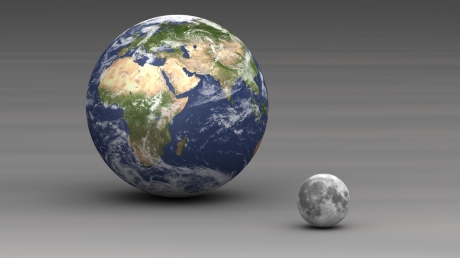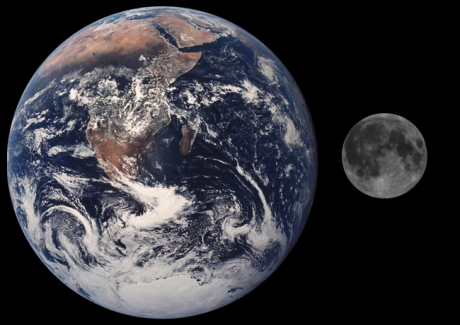Scale October 26, 2013
Posted by WorldbyStorm in Astronomy, Science, Uncategorized.trackback
It’s odd, it’s only in the last few months that I realised just how small the Moon is in relation to the Earth. Sure, I knew it was smaller, but I hadn’t thought about that fact in any detail probably in decades. If you asked me how much smaller I’d probably have guestimated somewhere about somewhere less than an half and greater than a third the size diameter (see comments) of the Earth. But no, the Moon is considerably smaller than that again.
How much? Well, look at these images here, about or a little less than a quarter the diameter.
And that’s interesting because recently looking at the Shadow of the Moon documentary, and this is probably what unconsciously sparked my thoughts in this direction, it seemed to me that the journey from the Command Module to the surface of the Moon seemed quite short. Very short. And it probably was, even accounting for editing, because the Moon has a surface area about that of Asia. Indeed look again at the image above and you’ll see that set up against the Earth (let’s not try that experiment for real – eh, folks?) it would be about as ‘high’, as Africa.
But that sparks a further thought. How far away is it? Well, the easy answer is that it’s … of course it is. But let’s think about that in more human terms of scale. Here’s the ever excellent Phil Plait’s Bad Astronomy blog and a post on just this matter.
If the Earth is the size of a basket ball and the Moon a tennis ball, and the ratio is more or less spot on, more rather than less I hasten to add, then the Moon would be 24 feet away! That’s quite a distance. There’s a bunch of videos on YouTube that show what other planets would look like if they were orbiting the Earth at the same distance as the Moon. I can’t say how accurate they are, some are probably there or thereabouts.
But as Plait says:
I’m sometimes asked what’s the one thing I wish people would understand better about the Universe. My answer is always the same: scale. We humans have a miserable sense of just how big space is, and I’ve spent a lot of time over the years working out ways to express it better.
And:
Space is big. Very, very big.
And using the same scale Plait makes a very thought provoking point. How far away is the nearest star from Earth?
It would be — to scale, mind you — 800,000 km (480,000 miles) away: twice as far as the real Moon is from the real Earth!
I’ve been thinking a lot about the prospects for human interstellar travel, and I’m moving to a position where I wonder if sheer scale is just too great a challenge, at least for the foreseeable future. Humans are notoriously bad at future planning, and there’s no proof that our artefacts can survive the sort of time spans required. Add those together and the lack of viable technologies and the future looks… isolated.
Charles Stross deals with this issue here… and funnily enough Robert Silverberg in the current edition of Asimov’s raises the point in a slightly different context.



A pedant writes: the moon is about the a quarter the diameter of the earth, so about one sixty fourth of the size.
As for interstellar travel (or Mars for that matter), forget it. The energy cost of getting something big enough to high enough speed, and recovering it, is prohibitive. A handy figure to keep in mind is that going to the moon required 3-4% of US government spending for a decade, and that during the Vietnam War. Mars is, literally, an order of magnitude more costly in energy terms, and you can’t repeal the laws of thermodynamics.
LikeLike
Pedant absolutely correct to point out the error, now corrected above. 1/64th really puts it in perspective.
Re Mars, while still orders of magnitude greater than the moon, with better tech surely (reassure me here Michael) it wouldn’t be unfeasible?
LikeLike
As Charles Stross points out, we’re not going there with rockets. The enabling technology might be the space elevator, which is essentially a problem in material science, rather than rocket surgery. If that can be built, the reduction in energy required to lift the spacecraft (i.e. the bits to assemble it in orbit) might make it thermodynamically feasible to get to Mars, but it’s still an awful long trip, especially if you’re planning to come back. I don’t have the numbers on me, but it’s about 250 days there, 500ish on the surface, and 250 back, at its fastest. That’s a long time to feed a crew and shield it from all the nasty rays, and you have to bring everything with you.
LikeLike
Yep, that’s a very good point. I guess at a push it might be possible to assemble stuff in orbit, but… who is going to do that at the moment? And space elevators are such a step upwards from where we are, even assuming the tech is possible… 😦
It does seem that broadly speaking we’re going to be a low earth orbit civilisation well into the future…
LikeLike
Bill Bryson had a very interesting example of scale in ‘A Brief History of Nearly Everything’, Where if the sun were a basketball then Pluto (still officially a planet when the book was written) would be a grain of sand a mile away. Not sure if that was exactly it but is was along those lines. I think we can forget about space travel as MC notes above. The physiological strains on the human body of travelling to Mars would be insurmountable even if we have more or less proven, after the recent Moscow experiment, that it is psychologically possible to have human beings cooped up in a spacecraft for a round trip to Mars.
LikeLike
That’s an interesting point you raise there CMK. The long term stays on the ISS and previous Soviet space stations indicate that while it is possible to live reasonably healthily in a zero-g environment there is significant muscle etc wastage which means astronauts are extremely weak when they return. Presumably the same dynamic would operate in relation to Mars, unless the craft is designed to include a centrifuge to create the effect of gravity. More mass, more weight, more problems.
LikeLike
I’m not certain of the science but I am certain of my capacity to bullshit: what I’ve seen is that the muscle wastage and bone density problems experienced by astronauts orbiting earth for prolonged periods are a serious problem. Any trip to Mars would exacerbate those by several orders of magnitude. The point about scale in the universe leads to very profound questions. If you think, for instance, that it would still take over fours years travelling at the speed of light to reach the nearest star in our galaxy. And then you have NASA publishing pictures of hundreds of galaxies clustered together in an obscure part of the over 13 billion years ago. Maths is not my strongpoint but then you get to the Drake Equation (I don’t know if it is scientifically credible, but it has an intuitive credibility) and you have to think that if the range of civilisations in the Milky Way alone goes from 10 to possibly millions, there must be other, far more technologically advanced civilisations elsewhere in the Universe. Anyway, here’s Carl Sagan on the Drake Equation: http://m.youtube.com/watch?v=0Ztl8CG3Sys
LikeLike
First sentence should read: ‘I’m NOT certain…..’[Edit by Tomboctu: Original comment now amended.]LikeLike
Speaking about scale… http://upload.wikimedia.org/wikipedia/commons/c/cc/Star-sizes.jpg
LikeLike
I think that we will – eventually – colonise Mars. The muscle wastage issues don’t sound insurmountable. Technology like 3d printers show us that we don’t necessarily need to transport all of the required technology there.
LikeLike